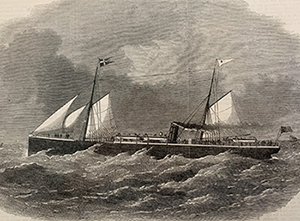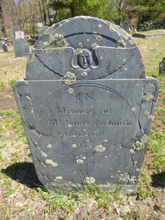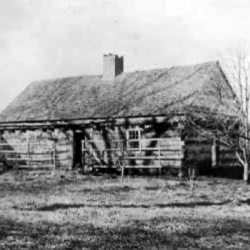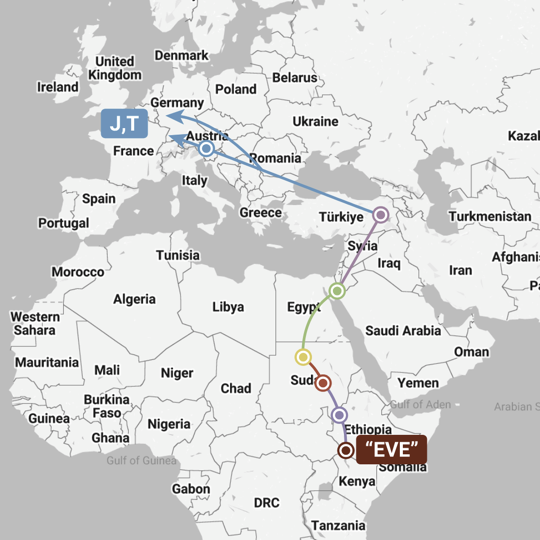
 My Old Dead Relatives
My Old Dead RelativesThe genealogy of my extended family
To guard against bots and hackers, we ask that you register and login to use this site. It's free and we don't spam, and this allows us to make our research available. Thanks for understanding. ~Cousin Kate
The story of our family is the story of the United States. Among the first settlers to the new world, from battles and wars to science and aviation, our ancestors have participated in significant events in our country's history. Blog
Family Stories

Originally from Cheshire, England, John Damme settled in Dover, NH in 1633.
Thomas Conary was a founder of Deer Isle, ME. All the early New England Conary's are his descendants. His father and siblings each spelled their name differently, including Connery, Connelly, Cornelly, Conrey, and Conry.
John Folsom and Mary Gilman, both from distinguished families, immigrated for religious reasons, producing many notable descendants.
Mary Baily showed strength and endurance during judgmental Puritan times.
Family Secrets Can Kill You. Clarence Leader Dame died chasing a burglar. He recently had heart sugery and hid it from his wife. Even his best friend and personal doctor was not aware of his condition. Although it happened in New Hampshire, this event made the papers in Boston.
Conaire Mor - The old saying "Every Irishman has a king or queen for an ancestor," might be true for our family. The Conary line is said to descend from Conaire Mor, the "Peace King", who traces his line back to Adam and Eve. View his remarkable lineage.
Josephus Sutton ended up on the wrong side of history when he enlisted in the Confederate army. We might never know why.
Witnesses to History

Lyman Sumner Walker - witnessed the surrender of Gen. Robert E. Lee
James Nesmith - served at Bunker Hill
Oliver Fisher Winchester - made the Gun That Won The West
David Sutton and wife Nancy hosted a stop on the Underground Railroad
Richard de Clare and Gilbert de Clare - forced King John to sign the Magna Carta
Asa Gurley Conary - Civil War sharpshooter
Zemira Palmer - witnessed the California Gold Rush
Willie Clifton Bradley - helped build Boulder Dam
Sarah Parker and Abigail Dane Faulkner - were among the accused of witchcraft in old Salem
Thomas Putnam - was an accuser during the Salem witch trials
Ebenezer Carleton - fought at Bunker Hill and Valley Forge
Mary Sloper - scalped by Indians but survived for many years
Harriette Patience Dame - Civil War nurse
Leonard Calvert - First Governor of Maryland

Originally from Cheshire, England, John Damme founded Dover, New Hampshire in 1633. He was a deacon at the church and farmed the land. When he was 80 years old, he was killed by Indians.

George settled in North Carolina to avoid persecution as a Quaker. Descended from Charlemagne and William the Conqueror, George married the daughter of his employer and had many children.

Hans and Siri brought half their children from Norway to settle in Iowa. Tired of toiling in the fields with little to show, they followed the American dream and flourished.

Mary was about 13 years old when she came with her parents aboard the Mayflower to Plymouth Rock. She is said to be the first European woman to set foot in the New World.
by Kate Montressor
The best summers were spent at Grandma's house on the rugged downeast coast of Maine. Our family would drive the hours-long journey from Boston to the sleepy small town of Blue Hill. We'd impatiently drive another mile out the other side of town on the Surrey Road. Laughter and sighs of relief filled our car when her house came into view - the first on the right after crossing the bridge.
Grandma's house was built 'northern' style with the barn attached by an enclosed porch. Long ago painted shut, the front door refused to open. Everyone entered through the back, making their way down a narrow dark hallway to grandma's kitchen.
The largest room in the house, the crowded yellow kitchen greeted guests with the mouth-watering aroma of blueberry pies and homemade doughnuts. A massive black wood-burning cook stove dominated the scene. Grandma kept it burning every day of the year. Heat and ash from the stove rose loftily through an overhead vent, warming the bedrooms above and permeating the blankets with the scent of wood smoke. Beside the stove squatted a battered old woodbox - the best place to sit in the wintertime.
In the far corner, a plain wooden table and a wringer washer stood beside the cellar door. Granddad's addition of a big old wooden platform rocker added to the Heinz 57 decor. On the north wall, the stained porcelain sink provided the only evidence of indoor plumbing. Trekking through the enclosed porch, the barn embraced you with the clean scent of horse and hay. Bright sunlight spilled in through the gaping plank walls. A wagon and sleigh stood to the right of the entrance, the horse stalls were on the left. Down the length of the barn, over the uneven dirt floor, through the back work shop, was the outhouse. A treacherous journey by day, no one ventured through at night.
Military Ancestors
James Nesmith, born in Ireland, was at Bunker Hill and served with Col Johnny Stark.
Conrad Cuntramann (Countryman) was acknowledged by Ripley's Believe It or Not for having 26 sons and grandsons serving in General Washington's army, the most of any family. Another son, Jacob, was a Tory.
Samuel Staples had been married twice and had 11 children and several grandchildren when the British soldiers arrived in Kittery, Maine. Samuel was in his 60s. The British grabbed him and forced him to serve on a war ship. He must have been more trouble than he was worth, because he was shot and thrown overboard, never to see his family again. This enraged the community and inspired many young men in the area to join General Washington's forces, including two of Samuel's sons.
Reuben Sutton joined Union forces on 30 Mar 1865, saw the closing of the Civil War, including at least 8 battles, Lee's surrender, and Lincoln's assassination. He was killed after 38 days of service.
Josephus Sutton crossed the border from Iowa to Missouri to join Confederate Forces. He was captured in Mississippi during the siege of Vicksburg, then later participated in a prisoner exchange.
Joshua Staples served 6 years 2 months in the Revolution as a private and a corporal, including the brutal winter at Valley Forge. He was well-thought of and served honorably. His discharge was personally signed by General Washington and he received the Badge of Merit.
James Allen and Ebenezer Eddy answered the call from Paul Revere at Lexington and Concord.
During the Civil War, Moses Friend Long was mortally wounded at the Battle of Fredericksburg, William Meade Dame fought heroically for the Confederacy. Peter Fort Countryman enlisted when Lincoln called, but was sent home after 3 months with severe diarrhea.
George Dame was a Loyalist and fought on the British side during the Revolution as a Lieutenant of the 8th Regiment of Foot. He lost his home in New Hampshire and his possessions when they were confiscated by American forces, but at wars' end, he was granted 3,000 acres in Bertie, Ontario, from the King. His cousin, George Dame was rewarded by the Continental Congress for providing aid to the Continental army.
Deborah Sampson fought during the American Revolution disguised as a man.
Mayflower Ancestors
William BRADFORD, first governor of Massachusetts, and author of Of Plymouth Plantation and his wife Ann.
William and Mary BREWSTER, and their young son, Love
Mary CHILTON - our female Mayflower ancestor; her parents, James CHILTON and his wife (name unknown) were also on the Mayflower, but did not survive the voyage
Thomas and Joseph ROGERS - father and son. Thomas died the first winter, then John lived with the Bradfords
John ALDEN - ship's cooper, and youngest person to sign the Mayflower Compact
Richard WARREN - probably part of the ship's crew, he left before the first winter and returned later with a family
William MULLINS, his second wife Elizabeth Wood, and his daughter, Priscilla MULLINS who later married John Alden
Stephen HOPKINS brought his second wife and children from both marriages, including Constance (our 10X great grandmother.
** List of Mayflower Ancestors **
** List of Migrant Ancestors **
More Reports

About 3-4 million years ago, our mothers followed the Nile, traveling out of Africa and into modern-day Turkiye. About 50,000 years ago, we lived in the Near East, including modern-day Iran, Jordan, Bahrain, and Lebanon. About 10,000 years ago, we followed the development of agriculture in Western and Eastern Europe, and Scandinavia, where we were some of the earliest farmers.
We can trace our family back to Charlemagne as well as some early Nordic, Pict, and Celtic kings (along with about 10 million other people).
Today, our DNA shows we settled in Scotland, Ireland, England, Sweden, Norway, and Germany for hundreds of years, before coming to America. Our Viking index is about 25%.
In olden days, people had one name. When several people in a community shared the same name, they commonly differentiated them based on their occupation, residence, or parentage. As the Romans traversed Europe and Great Britain, the custom for more uniform surnames were adopted.
Scandinavians incorporated the father's name by adding 'son' or 'daughter' (like Hanson or Hansdotter), a practice known as patronymic naming. Sometimes, they also identified themselves by the name of the farm they resided on, such as "Revlin". Unlike many cultures, Scandinavian women retained their maiden surname rather than adopting their husband's upon marriage. First names were often not unique, leading to multiple children within families sharing the same first name -- but distinguished by different middle names!
This website uses dates from the Gregorian calendar (New Style), unless otherwise noted.
For more information on dates, see Wikipedia: Old Style and New Style dates.
I strive to cite my sources. However, some people and dates are best guesses and will be updated as new information is revealed. If you have something to add, please let me know.
Crave more information? See my free blog at https://myolddeadrelatives.blogspot.com/.
Updated 19 Jun 2025